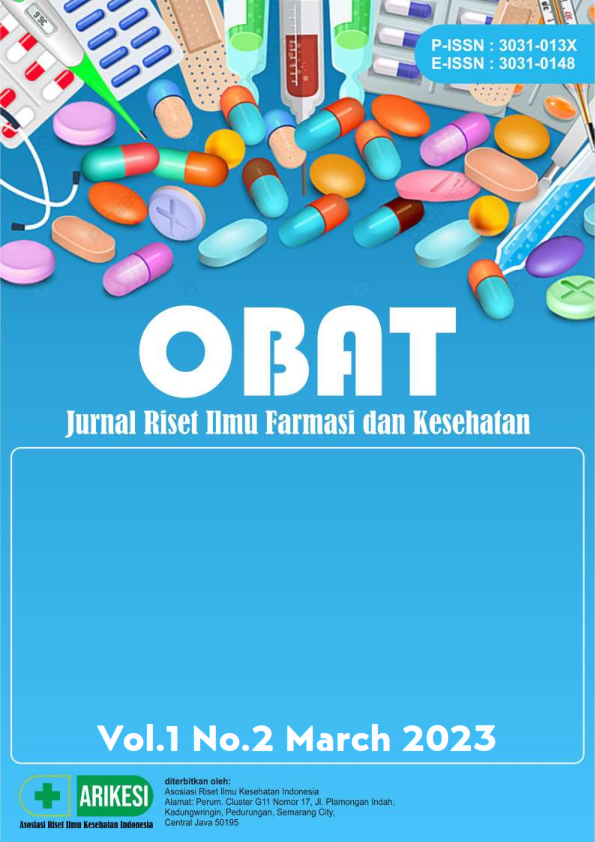Analisis Perubahan Frekuensi Nadi Pada Pasien Intra Anestesi Dengan Penggunaan Sevofluran
DOI:
https://doi.org/10.61132/obat.v1i2.1062Keywords:
Sevoflurane, Pulse rate, General AnesthesiaAbstract
Background: Hemodynamics is very important to monitor, especially in general anesthesia because generally anesthesia will cause various kindsof body system disorders. The use of anesthesia using inhalation using sevoflurane can cause hemodynamic changes, one of which is changes in pulse frequency. So that a strict monitoring process is needed in its use. Objective: Knowing changes in pulse frequency in general anesthesia patients with the use of sevoflurane at PKU Muhammadiyah Gombong Hospital in 2024. Methods: This study is an Observational Descriptive study with a quantitative research design that focuses on variable analysis, specifically intra anesthesia pulse frequency after sevoflurane is given. This study used an analytic design with a cross sectional approach. Results: Frequency Distribution of Respondent Characteristics Based on Age obtained research results where the most age group was 26-45 years as many as 23 respondents (51.1%). For the gender group, the results of this study with the most respondents were male as many as 30 respondents (66.7%). Distribution based on body weight obtained research results where the most weight The results showed that the most weight group was 41-75 kg as many as 40 respondents (88.9%). The results of observations of changes in the inhalation drug sevoflurane that the mean or average induction pulse frequency was 75.47 bpm, the mean or average pulse frequency after 5 minutes of induction it was 79.73 bpm, the mean or average pulse frequency after 10 minutes of induction was 79.29 bpm, and the mean or average pulse rate after 15 minutes of induction was 78.53 bpm. Conclusion: Changes in pulse frequency from the initial pulse to the pulse frequency after 15 minutes of induction can be said to have a normal/stable distribution. It can be seen from the mean or average of 72.93-79.73 bpm.
Downloads
References
Aditianingsih, D., Sukmono, B., Agung, T. A., Kartolo, W. Y., Adiwongso, E. S., & Mochtar, C. A. L. (2019). Comparison of the effects of target-controlled infusion of propofol and sevoflurane as maintenance of anesthesia on hemodynamic profile in kidney transplantation. Anesthesiology Research and Practice, 2019, 1-7. https://doi.org/10.1155/2019/5285193
Arvianto, E. O., & Eri, S. (2017). Perbandingan alntalral sevofluran dan propofol menggunakan total intravenous anesthesia target controlled infusion terhadap waktu puith saldair dan pemulangan pasien pada ekstirpasi fibroadenoma payudara. Jurnal Anestesi Perioperatif, 5(1), 24-31.
De Hert, S., & Moerman, A. (2015). Sevoflurane. F1000Research, 4, 1-8. https://doi.org/10.12688/f1000research.6232.1
Hapsari, N. (2011). Perbandingan efektivitas anestesi inhalasi halothane dan sevofluran terhadap perubahan hemodinamika (tekanan darah, nadi, dan saturasi oksigen) [Master’s thesis, Universitas Sebelas Maret].
Hudiya, A., Ghofur, A., & Endarwati, T. (2022). Sevofluran dan isofluran terhadap frekuensi nadi di RSUD Salak, Bogor. In Hudiyalll, Jakarta: Rineka Cipta, 79-92.
Imalgalwal, K., Komasawal, N., & Okamoto, K. (2015). Comparison of the hemodynamic effects of sevoflurane and desflurane during induction of anesthesia: A prospective randomized controlled trial. Osalkal Medical College, 61, 1-6.
Indrawati, A. (2010). Efektivitas rangsangan kombinasi titik akupuntur [Doctoral dissertation, EGC, Jakarta].
Let me know if you need any adjustments or further help!
Lewar, E. L. (2015). Efek pemberian obat anestesi inhalasi sevofluran terhadap perubahan frekuensi nadi intra-anestesi di kamar operasi Rumah Sakit Umum Daerah Umbu Ralral Meha Waingapu. Jurnal Anestesi Perioperatif, 5(2), 65-70.
Mangku, G., & Senapathi, T. G. A. (2010). Buku ajar ilmu anestesi dan reanimasi. Penerbit Indeks.
Notoatmodjo, S. (2010). Metodologi penelitian kesehatan. Rineka Cipta.
Nursalam. (2017). Metodologi ilmu keperawatan. Salemba Medika.
Ozdogan, H. K., & Cetinkunar, S. (2016). The effects of sevoflurane and desflurane on the hemodynamics and respiratory functions in laparoscopic sleeve gastrectomy. Journal of Clinical Anesthesia, 35, 441-445. https://doi.org/10.1016/j.jclinane.2016.04.003
Peraturan Menteri Kesehatan Republik Indonesia Nomor 18 Tahun 2016 tentang izin penyelenggaraan praktik penata anestesi. (2016).
Prisasantı, D. P. (2012). Efek anestesi inhalasi sevofluran dan isofluran terhadap perubahan tekanan darah arteri rerata (mean arterial pressure). [Master’s thesis, Universitas Sebelas Maret].
Suhidajat, J., & Jong, D. (2010). Buku ajar ilmu bedah (Edisi 3). Universitas Muhammadiyah Surakarta.
Downloads
Published
How to Cite
Issue
Section
License
Copyright (c) 2025 OBAT: Jurnal Riset Ilmu Farmasi dan Kesehatan

This work is licensed under a Creative Commons Attribution-ShareAlike 4.0 International License.





